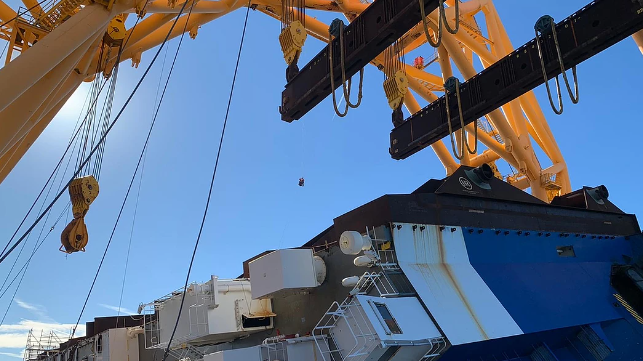Golden Ray Salvage Team Prepares for Second Hull Cut

Salvors are getting ready to begin the second cut through the hull of the stranded ro/ro Golden Ray, which partially capsized and went aground in St. Simons Sound, Georgia in September 2019.
The first cut removed Golden Ray's bow, and it took weeks longer than expected. The anchor chain used in the cutting operation parted, and the project's engineers had to make modifications to the setup before they could resume work. For the next section, salvors have made preliminary cuts along the expected path of the cutting chain to reduce the load, and their dive teams have drilled additional holes into the bottom of the hull in order to accelerate drainage when the section is hoisted out of the water.
The team has also repositioned the heavy lift barge VB-10000 over the location of the next cut in preparation. After rigging the lifting gear and setting up the cutting chain, they will begin the process of the second cut.

Tug crew handles mooring line to reposition the heavy lift barge VB 10000 over the wreck (St. Simons Sound Incident Response)

Plastic debris recovered from a nearby beach (St. Simons Sound Incident Response)

Bow section departs the site aboard the barge Julie B (St. Simons Sound Incident Response)
Meanwhile, the bow section has departed for a recycling yard in Louisiana aboard the deck barge Julie B. The initial plan called for loading both bow and stern sections onto the barge before the transit, but after the extended delay in completing the first cut and additional weeks of work in preparing for the second, the team has opted to send the barge ahead with one section only. The loose wrecked cars within the bow section have been secured, including some located on the deck of the barge.
After the outbreak that contributed to a temporary halt in late summer, the team has managed COVID-19 risk effectively, containing recent infections to non-essential staff. All personnel with roles that are critical to the wreck removal are in sequestered housing at a nearby resort, and they have not been affected since the resumption of work on the vessel in October.
While working on the reponse, personnel are required to use face coverings, practice social distancing and conduct work remotely where possible. Workers' temperatures are checked daily, and all incoming personnel have to sequester and take a COVID-19 test before working.
Plastic waste (car parts) has been recovered from the water and from local beaches, and responders have found and remediated light sheening near the wreck and the shoreline. The containment barrier system set up before the wreck removal process has helped to reduce the pollution risk from the cutting operations, which were expected to create limited releases of fuel oil and debris.
